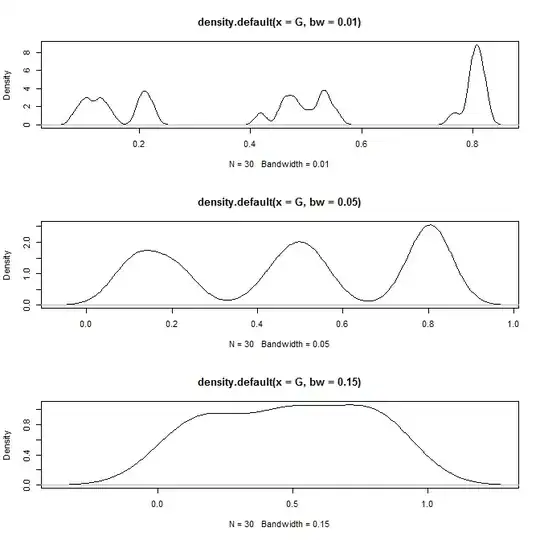I gather you don't care which shop a given customer uses preferentially, just if there are any that is used disproportionately often. You want to see if there are two or three naturally forming groups that can segment customers into those who preferentially shop at a given store versus those who shop equally often at all stores. In light of that, the following would be my suggestion:
- Start with a rectangular dataset in which the columns are the stores, each row is a customer, and in each cell lists a row-wise percentage (0-100).
- For each row, calculate a Gini coefficient. This is a measure of the inequality of store preference. It will vary from $0$ (all stores are visited exactly equally often—$10\%$ each) to $1$ (only one store is visited—$100\%$ with all others $0\%$). It can be calculated as:
$$
G_i = \frac{\sum_j\sum_{j'}|x_j-x_{j'}|}{2\sum_j\sum_{j'}x_j}
$$
- With a Gini coefficient for each row / customer, you can form a univariate distribution of values.
Any 1D clustering approach of your preference can now be applied. The idea of 1D clustering is discussed on CV here: Determine different clusters of 1d data from database.
(One strategy I might try is to run a series of kernel density estimates with different bandwidths, and see if two or three coherent clusters emerge with some bandwidth. You are looking for higher density regions separated by lower density regions. With 1 million customers, you could take a large random sample, find a bandwidth that you like and try a kernel density with that bandwidth on another, independent large random sample. If a nice-looking segmentation occurs twice with local minima in the same places, those minima can be used as breaks to segment your customers.)
Here is a simple demonstration, coded in R:
First, I'll generate some data. This creates 30 customers, of whom 10 shop at all stores equally, 10 strongly favor a particular store, and 10 are in between.
set.seed(4751) # this makes the demonstration exactly reproducible
x = matrix(runif(3000), ncol=30, nrow=100)
b = seq(from=0, to=1, by=.1); b3 = b^3; b10 = b^10
m = matrix(NA, nrow=30, ncol=10)
for(j in 1:30){
if(j<11){
cats = cut(x[,j], breaks=b, labels=1:10)
} else if(j<21){
cats = cut(x[,j], breaks=b3, labels=1:10)
} else {
cats = cut(x[,j], breaks=b10, labels=1:10)
}
m[j,] = as.matrix(table(cats)/100)
}
m[c(1:2, 11:12, 21:22),] # these are the first 2 from each set of 10:
# [,1] [,2] [,3] [,4] [,5] [,6] [,7] [,8] [,9] [,10]
# [1,] 0.15 0.10 0.06 0.08 0.12 0.09 0.14 0.06 0.16 0.04
# [2,] 0.10 0.15 0.11 0.11 0.06 0.09 0.14 0.14 0.07 0.03
# ...
# [3,] 0.00 0.00 0.04 0.06 0.04 0.15 0.08 0.20 0.16 0.27
# [4,] 0.00 0.02 0.02 0.01 0.03 0.10 0.12 0.19 0.20 0.31
# ...
# [5,] 0.00 0.00 0.00 0.00 0.00 0.00 0.03 0.05 0.21 0.71
# [6,] 0.00 0.00 0.00 0.00 0.00 0.00 0.02 0.07 0.25 0.66
Now I'll run the suggested algorithm:
library(ineq) # we'll need this package to get the Gini coefficient:
G = apply(m, 1, function(x){ ineq(x, "Gini") })
windows() # here I'm plotting the kernel density at different bandwidths
layout(matrix(1:3, nrow=3))
plot(density(G, bw=.01))
plot(density(G, bw=.05)) # bw=.05 looks good
plot(density(G, bw=.15))

Here are the x (Gini) values that correspond to local minima. They can be used to segment your customers.
d = density(G, bw=.05)
d$x[which(diff(sign(diff(d$y)))==2)]
# [1] 0.3265323 0.6563601
